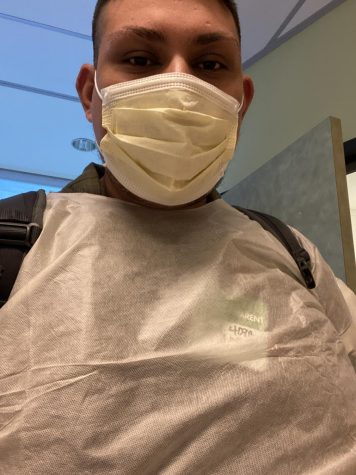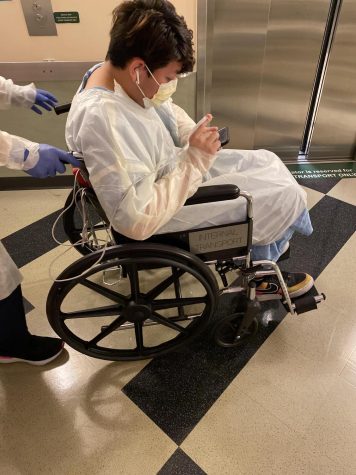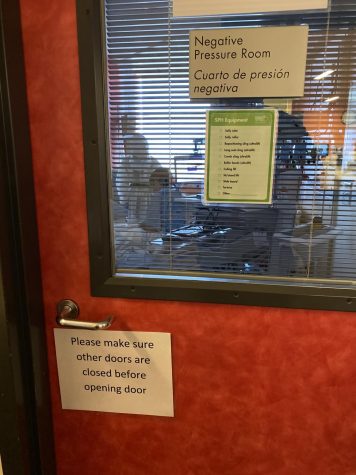Visting my nephew in the hospital’s COVID-19 ward
May 7, 2020

Myself covered in PPE getting ready to move from one side of the hospital to an area away from patients being treated for COVID-19.
When I was younger, I would take my good health for granted. I was in a fortunate situation where I never had a close family member become seriously sick or suffer from major health problems. That changed two years ago when one of my parents ended up in the hospital. It changed again when I lost a family member late last year.
Now, my 16 year-old nephew is in the Children’s Hospital Los Angeles during a pandemic.
My nephew’s respiratory symptoms and dry cough brought him to CHLA, and led the nurses and doctors to test him for the coronavirus.
On my nephew’s first night in the hospital, his temporary room was located on the fourth floor of the hospital where they treat patients who have been diagnosed with COVID-19, and where patients await their test results.
I was worried that my nephew might have something serious, since he was placed in a room on this floor.
“I’ll be fine,” he said. “I just want to feel better.”
This floor serves as a threshold to stop inpatients from entering areas with a high population of patients with the coronavirus. The hospital does this to make sure that patients that are sick with the virus don’t go to other places within the hospital and possibly spread it.
Inside the room that my nephew was in, there was only one patient bed and one sofa bed. The room was originally made to accommodate two patients, but it was converted into a single-patient room.
Two HEPA air scrubbers and negative air machines help purify the air in the room. Rooms with negative pressure prevent the likelihood of air in the room from slipping out into the corridors where the nurse station is, and where other people pass by.
The nurses wear full-on personal protective equipment along with powered air-purifying respirators that are tied at the waist and connected to a special suit to allow breathing.
While inside the room, I would glance outside through the openings of the door and notice that nurses take a minute or two to put on all of their gear before going into a patient’s room.
My nephew’s nurse knocked on the door and I got up to answer, only to be handed my nephew’s lunch. The nurse was very nice and had the patience to answer all of my questions regarding the plan for the day and what the next steps would be depending on my nephew’s COVID-19 test results.
Once my nephew’s test came back negative, it was time to move him from the fourth floor to the fifth floor across to the other side of the hospital. The hospital doesn’t want to risk people transmitting the virus, so we followed its preventative protocols.

Diego Hernandez is being transferred from a COVID-19 floor onto one where there aren’t any patients infected with the Coronavirus.
Before we could leave the room, the nurse handed my nephew and I PPE to wear since we were going to leave an area that treats COVID-19 patients to go to an area that does not. Once we both put on the PPE inside the room, it was time to move out.
After a long walk across the entire hospital, we went into another negative pressure room before it was safe to remove the PPE.
Once the nurse transferred us to the west side of the hospital, I could tell she was glad to be away from the floor we had been staying in. She seemed relieved that my nephew didn’t have COVID-19 and that he would no longer be in her unit. The nurse wished my nephew luck before she headed back.

The threshold from the outside hallway into a negative pressure room where the air in the room cannot escape.
The measures in the new unit were relaxed, but the doctors and nurses on this floor told us that they would continue to wear PPE around my nephew until they determined what illness he had.
I asked whether I needed to keep wearing my PPE, and they said that since I had been with my nephew, it would be easy to assume that I had been exposed to whatever he had. The doctors and nurses reminded me that although I hadn’t shown any symptoms, it didn’t mean I hadn’t contracted his illness.
Each day I would visit him, I would have to check-in and get a pass to go into the hospital. I remembered being asked the same questions every single time.
“Have you had fevers?”
“Do you have a cough?”
“Have you been exposed to someone with the coronavirus?”
After having my temperature taken by a nurse, I was allowed upstairs to see my nephew. These strict coronavirus measures seem to have everyone on edge, from the security guards to the receptionists up front.
My nephew was finally diagnosed with an inactive form of tuberculosis, a bacterial disease that affects the lungs. Since leaving the hospital nearly a week and half ago, my nephew has been recovering at home.
The cough, fevers and headaches have gone away. Twice a day, he has to take strong antibiotics prescribed to him to make sure the infection goes away.
My family anticipates he will have to visit the hospital for a check-up to ensure he doesn’t have any further complications inside his lungs. Despite being in the same building as COVID-19 patients, I feel content knowing there are teams of doctors and nurses that are taking the proper precautions to treat patients who have actually contracted the disease.